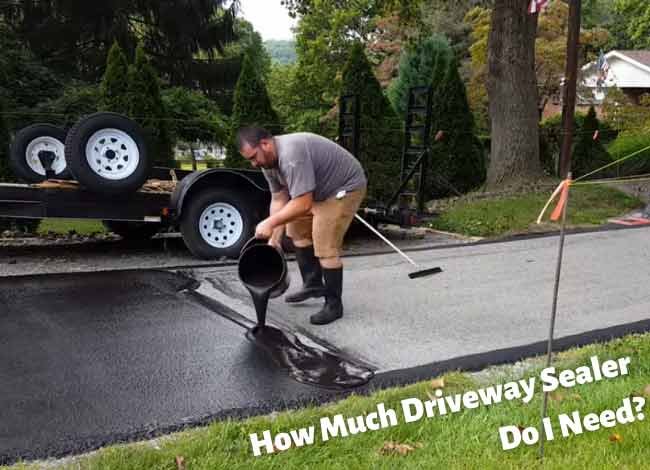Last Updated on May 12, 2025
Is your driveway looking faded and gray? That’s a clear sign it’s time for resealing due to years of wear and tear. Seasonal changes, oil and gas spills, and grease can damage the surface, making it prone to cracks and deterioration. Resealing not only restores your driveway’s appearance but also protects it from future damage.
Before buying a driveway sealer, it’s crucial to calculate how much product you’ll need. This ensures you don’t overbuy and waste money—or worse, underbuy and end up with patchy results.
How Much Driveway Sealer Do I Need?
To determine the right amount of driveway sealer, start by measuring the square footage of your driveway. The overall condition of your driveway also matters—severely damaged driveways may need more sealer. Follow these steps for accurate calculation:
Step-by-Step Guide to Measuring for Driveway Sealer
Step 1:
Divide your driveway into basic geometric shapes—rectangles, triangles, and semicircles—to simplify measurements.
Step 2:
- For rectangles: Measure the length and width.
- For triangles: Measure the base and height.
- For semicircles: Measure the radius.
Step 3:
Now calculate the area of each shape:
- Rectangle:
length × width - Triangle:
(base × height) ÷ 2 - Semicircle:
(3.14 × radius²) ÷ 2
Step 4:
Add the areas of all individual shapes to get your driveway’s total square footage.
Step 5:
To find how much sealer you need:
- Divide total square footage by 80 (since 1 gallon covers about 80 sq. ft).
- Then, divide that result by 5 to get the number of 5-gallon buckets required for one coat.
Step 6:
If your driveway is in poor condition, a second coat may be necessary. You won’t need as much for the second coat—only around 66% of the first coat amount. Multiply your first coat gallon total by 0.66 to estimate the second coat volume.
Step 7:
Add the quantities for both coats to get your total required sealer. Finally, round up to the nearest 5-gallon bucket to ensure complete coverage.
Pro Tip:
Always buy a little extra to account for surface texture and absorption rate variations—especially for older, porous driveways.
Related article: How can you remove moss from your driveway?
Other Things to Consider When Determining the Amount of Sealer You Need
1. Should I Fill the Cracks and Holes Before Sealing?
Yes, it’s essential to repair significant cracks and holes before applying a sealer. If your driveway has large gaps or deep cracks, simply using a sealer won’t be effective. Use a high-quality crack filler or patching compound to repair these areas first. Only after that should you calculate how much sealer is needed. This ensures better coverage and a longer-lasting finish.
2. Choose the Right Type of Driveway Sealer
There are various types of driveway sealers available, including asphalt and concrete sealers. It’s crucial to select the correct one based on your driveway material. Additionally, some sealers are specially formulated for older or weathered driveways, while others are better suited for newer surfaces. Make sure you read the product label and choose a formula that matches your driveway’s specific condition for optimal results.
Conclusion
By following this simple guide, estimating the amount of driveway sealer you need becomes much easier. Always apply the sealer evenly and according to the manufacturer’s instructions to achieve a smooth and durable finish. If your driveway is in poor condition, consider adding at least one extra gallon of sealer to cover the rough or highly absorbent areas.
From now on, there’s no need to guess how much driveway sealer you should buy. Measure your driveway accurately, choose the right type of sealer—whether it’s for asphalt or concrete—and ensure proper surface preparation for the best outcome. A quality driveway sealer not only protects your surface from damage but also enhances its appearance and longevity.
We hope this guide has helped you get the information you were searching for. Good luck with your driveway sealing project!

